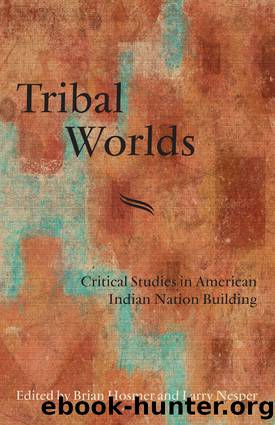Tribal Worlds by Hosmer Brian;Nesper Larry; & Larry Nesper

Author:Hosmer, Brian;Nesper, Larry; & Larry Nesper [Hosmer]
Language: eng
Format: epub
ISBN: 3408710
Publisher: State University of New York Press
Published: 2013-02-27T00:00:00+00:00
Constructing Images
While nationalism of any kind needs to create external alterity, it also needs to project and create internal homogeneity. Nationalism, the politicization of culture into ethnicity, ârequire[s] the active construction of a non-existent homogeneity that constructs and binds the population of a territory onto a âcommunity.â â22 The imagined community, then, has to be created in reality, and homogeneity has to be achieved according to the basic principles underlying the imagined ideal community. Homogenous spaces are first imagined, demanded, projected, and created in language. Once this ethnic or nationalistic rhetoric exists, however, it can wield practical power if read literally. Specific language use, even if created to have oppressed voices heard, can thus contribute itself to the silencing of voices. In fact, part of every nationalistic program has to be the silencing of heterogeneous voices, to render the harmonyâor, depending on the perspective, cacophonyâof historically diverse voices into a repetitive monotone and monologue. In the words of Manuhuia Barcham; âIn the transference of ideas of group identity to the level of policy implementation, an operational âpolitics of differenceâ based on this atemporal dichotomy of being/nonbeing may leadâthrough the synchronic reification of communityâto the exclusion and associated increase in levels of oppression among the very groups that the âpolitics of differenceâ were created to assist.â23 While a valid and useful political strategy, indigenous nationalism may end up hurting indigenous communities if it emphasizes cultural alterity to the point where ethnicity excludes specific, situational community alternatives to official realities.
George Tinker delineates four categorical differences between indigenous cultures and the West: spatial instead of temporal thought, communitarian instead of individual orientation, interrelatedness instead of alienation, and finally the notion that âownership, even group ownership, of land is a foreign concept to Indian peoples.â24 These are probably the four most commonly held parts to the perceived alterity between indigenous and Western people in general. Ironically, all of these images have their roots in the Western romantic critique of the enlightenment rather than in cultural realities. The argument of indigenous alterity that these points make, then, follows the romantic idea of the âprimitive,â who is free of alienation, knows no property, cannot exist except in the group, and has no concept of time.25
The notion of territoriality and ownership has been one of the main points deployed to counter industrial alienation and capitalist economies that have exploited indigenous peoples' resources. Eric Cheyfitz writes that even âcommunal property, ⦠from a traditional Native standpoint is an oxymoron.â26 Judging from students in my classes, this notion is also very popular in mainstream education. If students know anything about indigenous peoples it is that American Indians lived a communitarian existence without personal or even communal property or a sense of the individual, but with an extremely heightened sense of sacredness. I have found it almost impossible to convince both Native and non-Native students that Plains Indians owned horses, for example. Animals, they argued, simply passed through the hands of people, but could never be owned because they were sacred.
Download
This site does not store any files on its server. We only index and link to content provided by other sites. Please contact the content providers to delete copyright contents if any and email us, we'll remove relevant links or contents immediately.
Cecilia; Or, Memoirs of an Heiress — Volume 1 by Fanny Burney(32018)
Cecilia; Or, Memoirs of an Heiress — Volume 3 by Fanny Burney(31434)
Cecilia; Or, Memoirs of an Heiress — Volume 2 by Fanny Burney(31378)
The Great Music City by Andrea Baker(30630)
We're Going to Need More Wine by Gabrielle Union(18598)
All the Missing Girls by Megan Miranda(14558)
Pimp by Iceberg Slim(13703)
Bombshells: Glamour Girls of a Lifetime by Sullivan Steve(13661)
Fifty Shades Freed by E L James(12882)
Talking to Strangers by Malcolm Gladwell(12805)
Norse Mythology by Gaiman Neil(12774)
For the Love of Europe by Rick Steves(11327)
Crazy Rich Asians by Kevin Kwan(8858)
Mindhunter: Inside the FBI's Elite Serial Crime Unit by John E. Douglas & Mark Olshaker(8661)
The Lost Art of Listening by Michael P. Nichols(7115)
Enlightenment Now: The Case for Reason, Science, Humanism, and Progress by Steven Pinker(6851)
The Four Agreements by Don Miguel Ruiz(6278)
Bad Blood by John Carreyrou(6251)
Weapons of Math Destruction by Cathy O'Neil(5795)
